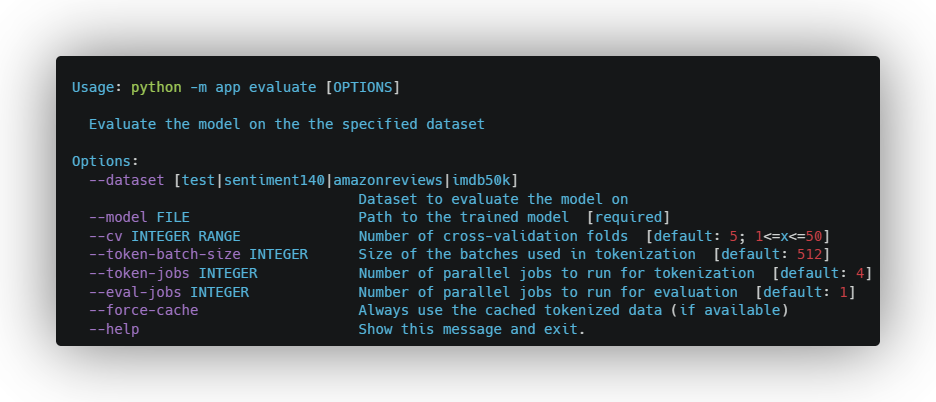| title | emoji | colorFrom | colorTo | pinned | sdk | python_version | app_file | datasets | models | |||||
|---|---|---|---|---|---|---|---|---|---|---|---|---|---|---|
Sentiment Analysis |
🤗 |
blue |
green |
false |
gradio |
3.11 |
app/gui.py |
|
|
This is a simple sentiment analysis model written in Python, designed to predict whether the provided text has a positive or negative sentiment. The project comes with both a graphical user interface and a command-line interface. While training the model, the user can choose from a couple of datasets to train the model on and then evaluate the trained model on another dataset. Once the model is trained, it can be used to predict the sentiment of any text with the help of the GUI or CLI.
Clone the repository and once inside the directory, run the following command to install the dependencies:
python -m pip install -r requirements.txtEnsure that you have at least one dataset downloaded and placed in the data directory before running train.
For evaluate, you will need the test dataset. See Datasets for more information.
The project comes with pre-trained models that can be used for prediction. See Pre-trained Models for more information.
- Python 3.11+
To see the available commands and options, run:
python -m app --helpTo perform sentiment analysis on a given text, run the following command:
python -m app predict --model <model> I love this moviewhere <model> is the path to the trained model.
Alternatively, you can pipe the text into the command:
echo "I love this movie" | python -m app predict --model <model>To launch the GUI, run the following command:
python -m app gui --model <model>where <model> is the path to the trained model. Add the --share flag to create a publicly accessible link.

After running the command, open the link from the terminal in your browser to access the GUI.

Before training the model, ensure that the specified dataset is downloaded and can be accessed at its respective path. To train the model, run the following command:
python -m app train --dataset <dataset> {options}where <dataset> is the name of the dataset to train the model on. For available datasets, see Datasets.
The trained model will be exported to the models directory.
To see all available options, run:
python -m app train --helpOnce the model is trained, you can evaluate it on a different dataset by running the following command:
python -m app evaluate --model <model>where <model> is the path to the trained model. For available datasets, see Datasets.
To see all available options, run:
python -m app evaluate --help| Option | Path | Notes | Dataset |
|---|---|---|---|
| sentiment140 | data/sentiment140.csv |
Twitter Sentiment Analysis | |
| amazonreviews | data/amazonreviews.bz2 |
only train is used | Amazon Product Reviews |
| imdb50k | data/imdb50k.csv |
IMDB Movie Reviews | |
| test | data/test.csv |
only used in evaluate |
Sentiment Analysis Evaluation Dataset |
During text preprocessing, this slang map is used to convert slang words to their formal form.
| Option | Description | When to Use |
|---|---|---|
count |
Count Vectorizer | When the frequency of words is important |
tfidf |
TF-IDF Vectorizer | When the importance of words is important |
hashing |
Hashing Vectorizer | When memory is a concern |
The following environment variables can be set to customize the behavior of the application:
| Name | Description | Default |
|---|---|---|
MODEL_DIR |
the directory where the trained models are stored | models |
DATA_DIR |
the directory where the datasets are stored | data |
CACHE_DIR |
the directory where cached files are stored | .cache |
The input text is first preprocessed and tokenized using re and spaCy where:
- Any HTML tags are removed
- Emojis and slang words are converted to their text form
- Stop words, punctuation and special characters are removed
- URLs, email addresses and numbers are removed
- Words are converted to lowercase
- Lemmatization is performed (words are converted to their base form based on the surrounding context)
After tokenization, feature extraction is performed on the tokens using the chosen vectorizer. Each vectorizer has its own advantages and disadvantages, and the choice of vectorizer can affect the speed and accuracy of the model (see Vectorizers). The extracted features are then passed to the classifier which predicts the class which in this case is the sentiment of the text. Both the vectorizer and classifier are trained on the specified dataset.
%%{ init : { "flowchart" : { "curve" : "monotoneX" }}}%%
graph LR
START:::hidden --> |text|Preprocessing
subgraph Preprocessing
direction TB
A[Tokenizer]
B1[HashingVectorizer]
B2[CountVectorizer]
B3[TfidfVectorizer]
A --> B1
A --> |tokens|B2
A --> B3
B1 --> C1:::hidden
B2 --> C2:::hidden
B3 --> C3:::hidden
end
Preprocessing --> |features|Classification
subgraph Classification
direction LR
D1[LogisticRegression]
end
Classification --> |sentiment|END:::hidden
classDef hidden display: none;
The following pre-trained models are available for use:
| Dataset | Vectorizer | Classifier | Features | Accuracy on test | Accuracy on self | Model |
|---|---|---|---|---|---|---|
imdb50k |
tfidf |
LinearRegression |
20 000 | 75.63% ± 4.73% | 89.24% ± 0.13% (5-fold) | Here |
sentiment140 |
tfidf |
LinearRegression |
20 000 | 75.63% ± 4.73% | 77.32% ± 0.28% (5-fold) | Here |
amazonreviews |
tfidf |
LinearRegression |
20 000 | 65.49% ± 7.03% | 90.08% ± 0.00% (train-test) | Here |
Distributed under the MIT License. See LICENSE for more information.




